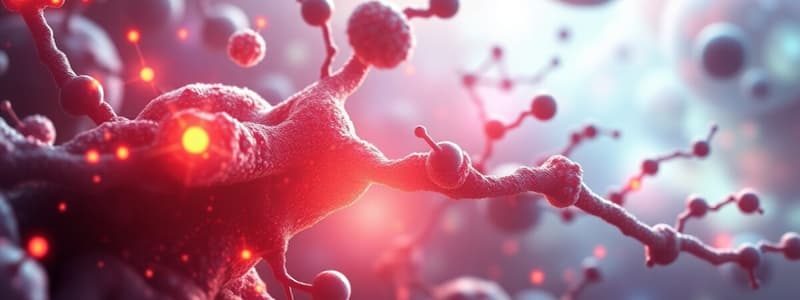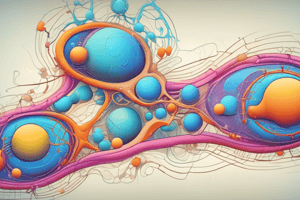Podcast
Questions and Answers
What is the net gain of ATP produced during glycolysis?
What is the net gain of ATP produced during glycolysis?
- 2 ATP (correct)
- 6 ATP
- 0 ATP
- 4 ATP
In which part of the cell does the Krebs cycle occur?
In which part of the cell does the Krebs cycle occur?
- Mitochondrial matrix (correct)
- Cytoplasm
- Thylakoid membrane
- Cell membrane
During oxidative phosphorylation, what is the final electron acceptor?
During oxidative phosphorylation, what is the final electron acceptor?
- Carbon dioxide
- Oxygen (correct)
- Hydrogen
- NADH
Which process in anaerobic respiration produces lactate in animals?
Which process in anaerobic respiration produces lactate in animals?
What is the primary outcome of non-cyclic photophosphorylation?
What is the primary outcome of non-cyclic photophosphorylation?
What is the primary function of the Calvin Cycle?
What is the primary function of the Calvin Cycle?
In cyclic photophosphorylation, which of the following is true?
In cyclic photophosphorylation, which of the following is true?
Which enzyme catalyzes the carbon fixation process in the light-independent reactions?
Which enzyme catalyzes the carbon fixation process in the light-independent reactions?
What is the main role of ATP in the regeneration stage of the Calvin cycle?
What is the main role of ATP in the regeneration stage of the Calvin cycle?
Which hormone is secreted by beta cells in response to hyperglycemia?
Which hormone is secreted by beta cells in response to hyperglycemia?
What occurs in response to hypoglycemia?
What occurs in response to hypoglycemia?
During the depolarization phase of nervous transmission, which ion primarily enters the axon?
During the depolarization phase of nervous transmission, which ion primarily enters the axon?
What happens to blood vessels when the body temperature is too high?
What happens to blood vessels when the body temperature is too high?
What is the role of osmoreceptors in the hypothalamus?
What is the role of osmoreceptors in the hypothalamus?
Which neurotransmitter is released at the synaptic knob upon an action potential?
Which neurotransmitter is released at the synaptic knob upon an action potential?
How is resting potential maintained in a nerve axon?
How is resting potential maintained in a nerve axon?
What is the primary function of glucagon?
What is the primary function of glucagon?
What is the effect of vasoconstriction in response to cold temperatures?
What is the effect of vasoconstriction in response to cold temperatures?
Flashcards
Carbon Fixation
Carbon Fixation
The process by which carbon dioxide from the atmosphere is incorporated into organic molecules, primarily glucose.
Rubisco
Rubisco
The enzyme that catalyzes the first step of carbon fixation in the Calvin cycle, combining CO2 with RuBP.
RuBP
RuBP
The five-carbon sugar molecule that combines with CO2 in the first step of the Calvin cycle.
GP (Glycerate 3-phosphate)
GP (Glycerate 3-phosphate)
Signup and view all the flashcards
Reduction (Calvin Cycle)
Reduction (Calvin Cycle)
Signup and view all the flashcards
Regeneration (Calvin Cycle)
Regeneration (Calvin Cycle)
Signup and view all the flashcards
Hyperglycemia
Hyperglycemia
Signup and view all the flashcards
Hypoglycemia
Hypoglycemia
Signup and view all the flashcards
Insulin
Insulin
Signup and view all the flashcards
Glucagon
Glucagon
Signup and view all the flashcards
Glycolysis
Glycolysis
Signup and view all the flashcards
Link Reaction
Link Reaction
Signup and view all the flashcards
Krebs Cycle
Krebs Cycle
Signup and view all the flashcards
Oxidative Phosphorylation
Oxidative Phosphorylation
Signup and view all the flashcards
Anaerobic Respiration
Anaerobic Respiration
Signup and view all the flashcards
Photosynthesis
Photosynthesis
Signup and view all the flashcards
Light-dependent Reactions
Light-dependent Reactions
Signup and view all the flashcards
Light-independent Reactions (Calvin Cycle)
Light-independent Reactions (Calvin Cycle)
Signup and view all the flashcards
Study Notes
ATP Synthesis in Respiration
-
Glycolysis occurs in the cytoplasm. Glucose (6C) is phosphorylated to glucose-6-phosphate using 2 ATP. Glucose splits into two triose phosphate molecules. Oxidation to pyruvate releases 2 NADH and 4 ATP (net gain of 2 ATP).
-
Link Reaction takes place in the mitochondrial matrix. Pyruvate loses CO2 and forms NADH, producing acetyl-CoA.
-
Krebs Cycle involves acetyl-CoA (2C) combining with oxaloacetate (4C) to form citrate (6C). Decarboxylation and dehydrogenation reactions produce 2 CO2, 3 NADH, 1 FADH2, and 1 ATP per cycle, regenerating oxaloacetate.
-
Oxidative Phosphorylation happens in the inner mitochondrial membrane. Electrons from NADH and FADH2 travel along the electron transport chain (ETC), creating a proton gradient. H+ ions flow through ATP synthase, producing ATP. Oxygen is the final electron acceptor, creating water.
Anaerobic Respiration
-
Animals use pyruvate reduction to lactate, regenerating NAD+ for glycolysis.
-
Plants/Microorganisms convert pyruvate to ethanol and CO2, oxidizing NADH to NAD+.
Photosynthesis
Light-dependent Reactions
-
Non-cyclic Photophosphorylation: Light excites electrons in photosystem II (PSII); electrons pass down an electron transport chain (ETC), pumping H+ into the thylakoid lumen. H+ flow through ATP synthase produces ATP. Electrons from PSII replenish PSI. Electrons from PSI reduce NADP+ to NADPH.
-
Cyclic Photophosphorylation involves only photosystem I (PSI). Electrons cycle back to PSI via the ETC, creating ATP, but no NADPH or oxygen.
Light-independent Reactions (Calvin Cycle)
-
Location: Stroma of chloroplasts.
-
Stages:
- Carbon Fixation: CO2 combines with RuBP (5C) to form two molecules of 3-PGA (3C), catalyzed by rubisco.
- Reduction: 3-PGA gets reduced to triose phosphate (TP) using NADPH and ATP.
- Regeneration: Some TP regenerates RuBP for further carbon fixation, using ATP.
-
Products: Glucose, other carbohydrates, and organic molecules are produced from TP.
Homeostasis
Regulation of Blood Glucose
-
Hyperglycemia: Beta cells in the pancreas detect high blood glucose and release insulin, promoting glucose uptake and glycogen formation (glycogenesis) in the liver.
-
Hypoglycemia: Alpha cells in the pancreas detect low blood glucose and release glucagon. Glucagon promotes glycogen breakdown (glycogenolysis) and glucose synthesis (gluconeogenesis).
Regulation of Temperature
-
High Temperature: Vasodilation (widened blood vessels), sweating, and reduced metabolic rate help cool the body.
-
Low Temperature: Vasoconstriction, shivering (muscle contractions), and increased metabolic rate with adrenaline and thyroxine aid in heat production.
Osmoregulation
-
Water Loss: Osmoreceptors in the hypothalamus detect low water levels and trigger the release of ADH from the posterior pituitary, increasing water reabsorption in the collecting duct.
-
Water Excess: Reduced ADH secretion decreases water reabsorption, promoting water excretion.
Control and Coordination
Nervous Transmission
-
Resting Potential: Sodium-potassium pump maintains a negative internal charge (-70 mV) by actively transporting 3 Na+ out and 2 K+ in.
-
Depolarization: Stimulation opens Na+ channels, allowing Na+ influx causing a less negative membrane potential.
-
Repolarization: Opens K+ channels causing K+ efflux, restoring the negative membrane potential.
-
Hyperpolarization: Excess K+ outflow results in a potential drop below resting potential, re-established by the sodium-potassium pump.
Synaptic Transmission
- Arrival of an action potential at the synaptic knob triggers Ca2+ channels opening and Ca2+ influx. Causing neurotransmitter vesicles release neurotransmitters (e.g., acetylcholine) into the synaptic cleft. Neurotransmitters bind to receptors on the postsynaptic membrane, triggering an action potential in the postsynaptic neuron.
Hormonal Coordination
- Endocrine System: Hormones are released into the bloodstream, targeting specific cells with matching receptors. Examples include adrenaline (fight-or-flight) and insulin (blood glucose regulation).
Studying That Suits You
Use AI to generate personalized quizzes and flashcards to suit your learning preferences.





